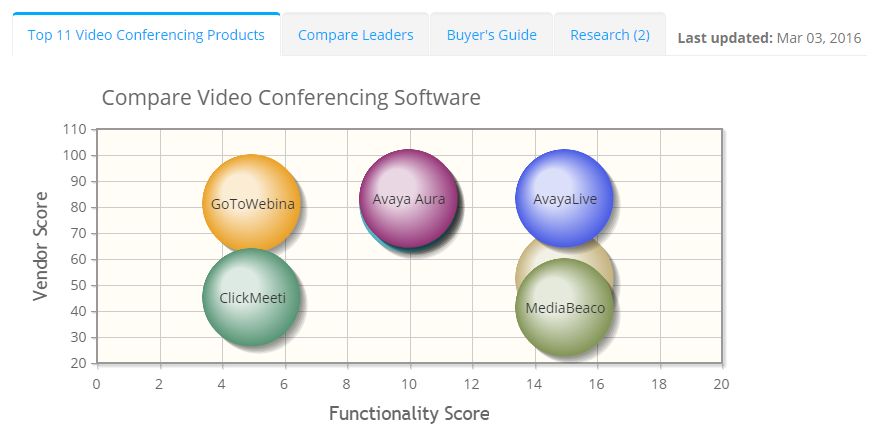We publish unbiased reviews. Our opinions are our own and are not influenced by payments from advertisers. This content is reader-supported, which means if you leave your details with us we may earn a commission. Learn why ITQlick is free .
A Buyer's Guide to Video Conferencing Solutions
Communications Software Buyer’s Guide
Most people in the telecommunications industry will all agree that Skype is not just a communication platform that features ease of use and video calling functionality. That is, in order for this Voice over Internet Protocol (VoIP) system to work at its best, technical engineers will be required. Their job is to ensure that the VoIP system can deliver the voice communications and multimedia sessions over Internet Protocol (IP) networks, such as the Internet, without any issues. VoIP involves signaling, channel setup, digitization of the analog voice signals, and encoding. What these technical terms mean to a business owner or chief executive who wants to invest in such communications system is pretty straightforward – that is to bring a technical person on board and allow him together with your management team to analyze your business requirements on telephony systems.
Thinking ahead of your technical requirements, we from ITQlick.com would want to assist you in strengthening your plan over acquiring or upgrading your communications system. This Buyer’s Guide will walk you through the basic requirements and technical considerations in selecting the right Communications Software solution for your organization. Just to give you a heads up, VoIP and Virtual/IP Private Branch Exchange (PBX) are both communications software solutions (with different features entailed with them) and you should not in whatever way be confused of that. In this Buyer’s Guide, we will generally discuss communication software solutions but will use the terms VoIP and virtual/IP PBX interchangeably to refer to a solution.
Types
There are two major types of communications software solutions and they are as follows.
Voice over Internet Protocol (VoIP)
This system relies on the Internet to operate. It is well suited for small businesses where only a few phone lines and voicemail systems are required during regular operations. Adequate amount of bandwidth is needed in order to ensure high-quality phone calls with minimal disturbances.
Virtual/IP Private Branch Exchange (PBX) Phone System
Compared to VoIP, this solution is well suited for most medium and large enterprises. PBX operates via switching equipments which allows the routing of phone calls to different phones inside and outside your business premise. Virtual PBX is an upgraded version of the traditional PBX; it can be integrated with your VoIP or landline systems. The IP PBX is very much like any other client-server application. It operates at the IP layer enabling users to utilize their data network or even the Internet for voice transmission.
On a technical perspective, such solutions are used for the setup and management of digital communication networks such as LAN and WAN, email, fax, A/V networks and wireless communication systems (ex. Wi-Fi). Here are the types of VoIP and IP PBX solutions available in the market today. We highly recommend that you conduct your own research in order to assess which of these solutions can best serve your organization’s requirements for a communication system.
Hosted VoIP
In a hosted VoIP, the call control (CPE-based IP PBX or softswitch-based) is located in the service provider’s network. A softswitch is a carrier grade IP PBX that is capable of delivering voice to multiple customers at the same time. Customer Premises Equipment (CPE) is the terminal and equipment located at a subscriber's premises and connected with a carrier's telecommunication channel.
Managed VoIP
In a Managed VoIP, the call control is located in the customer’s premise or network. The service provider is in charge of installing, testing and deploying the CPE in the customer’s location.
Pure IP PBX
A pure IP PBX is a software-based version of a traditional PBX and it often delivered together with a piece of equipment. Since pure IP PBX delivers the voice via the data network, it offers a higher degree of flexibility when it comes to options on where to deploy the call control unit.
Hybrid IP PBX
This solution is a combination of old TDM network and IP.
Features
Getting down into the features and their equivalent benefits to your business is of vital importance on your search for the right communications software solution. Here are the benefits that you can get from investing on this software solution.
Faster Time to Market
-
Fully portable, platform-independent software
-
Simple yet flexible interfaces with a large base of trained developers
-
Mature, field-proven products integrated into a wide variety of network elements
-
Advanced calling features
-
Mobility of telephony features
Reduced Costs
-
Multi-threaded software solutions that provide optimal performance scalability
-
Consistent architecture to facilitate integration
-
Integrated systems that enable customers to focus on apps
-
Lower infrastructure costs, including lower network management and toll costs
Reduced Risk
-
Standards-based products and processes
-
Professional services and global technical support
-
Robust fault-tolerant and distributed fault-tolerant solutions
Here are the most common features that VoIP and Virtual PBX service plans has to offer.
-
Bandwidth utilization and inbound/outbound call detail reports
-
Auto-Attendant
-
Basic calling
-
Call log records
-
Call transfers
-
Caller ID
-
Call screening
-
Choose your area code
-
Click-to-Call Widgets
-
Conference calling
-
Directory services including blocking
-
Do Not Disturb
-
Fax number
-
Forward to mobile
-
In-Network Calling for Free
-
Integration with Outlook
-
Messaging alert features
-
Network Unavailable Forwarding
-
Ringtones and individualized messages
-
Tech support
-
Voice Mail Folders
-
Voice Mail to Email Transcription
-
Voice Mail with Personalized Messages
-
Web interface
-
Door phone entry buzzer integration
-
Find me/follow me call routing
-
Music on hold
-
Coaching tools
Solutions per Business Size, per Vendor
There are more than one hundred VoIP/IP PBX providers in the world to date and it is important that you conduct a survey of the solution providers available in your business location. When comparing communications software solution providers, check for the price model, features, service plan and reliability of their system. Other than those, also consider checking these parameters.
Fair use limit
Fair Use Limit tells you how many minutes you can use per month. On unlimited plans, this usually ranges from 5,000 to 10,000 calling minutes per user per month. Knowing the Fair Use Limit can protect the network from overuse. And if you exceed the set amount, you will be charged extra.
International calls
International calling can be included in the monthly subscription, or it will be a metered rate per minute based on your country. To save money, it is important that you compare the rates to the countries you call the most.
Equipment types
Equipment types are good to understand when it comes to cost efficiency. In some cases, you will have to invest in your own equipment, while other plans provide the equipment. You need to know if the VoIP/IP PBX service provider supplies SIP (Session Initiation Protocol) trunking services.
Plan type
Each VoIP/IP PBX company offers different types of service plans; some are metered while others are unlimited plan. Study the features on each plan and select the right plan that will benefit your company the most.
Here is a shortlist of solutions providers where you can further verify the above features-to-consider.
-
BopCall
-
MyWebCalls.com
-
PennyTell
-
CallCentric
-
ViperNetworks
-
VBuzzer
-
Efonica
-
ON4
-
SparVoIP
-
Call On the Net
-
Go2Call
Pricing Considerations
Communications software solutions pricing model are basically based on the deployment models which are: Hosted VoIP, Managed IP PBX, Hybrid IP, and Pure IP.
Hosted VoIP requires no upfront cost and since service is located in the cloud, that means you can benefits from faster upgrade and repair time whenever there is a need. Managed IP PBX has lower upfront cost and the solution provider will be responsible in managing the converged network. Hybrid IP can make a significant investment to organizations who want to migrate from TDM PBXs to VoIP. However, most hybrid systems do not provide the same level of application integration compared to pure IP system. Pure IP has more flexibility in terms of deployment but requires significant upfront costs.
Cisco, Avaya, Nortel, 3COM and Mitel are all traditional IP PBX equipment vendors that have comprehensive VoIP/IP PBX solutions tailored for the enterprise market.
Skype, Vonage, Yahoo and Jajah are all emerging players that can provide consumer market the alternatives to traditional voice services.
As a reminder, always assess the real needs of your business. And as our advice from ITQlick.com, consider providing answers to these questions. What are you requirements for long distance calls, voice quality, and phone numbers? How do you consider taxes, maintenance costs, warranty periods, training times, E-911 capabilities, backup power, and interoperability with other equipments?
Market Trends
Despite of the challenges on service and voice quality, unproven ROI and TCO metrics, and security compliance that most communication software solutions are facing in the past several years, this market is growing at a faster rate. In fact, according to a recent report, VoIP and SIP revenues are expected to grow from $717.3 million in 2009 to $3.9 billion by 2016. Another research says that the worldwide business VoIP service is forecasted to grow by 7% compound annual growth rate (CAGR) from 2012 to 2017.
SIP (Session Initiation Protocol) trunking or using VoIP to facilitate the connection of a PBX to the Internet is emerging as a large growth area for enterprise VoIP.
Mobile VoIP is gathering momentum allowing employees to enjoy all the features they need on a phone at a lower cost than a traditional provider can offer.
Hosted VoIP continue to be the ideal solution for SMBs. However, many large enterprises are also beginning to implement this solution into their organization. These are positives signs that VoIP in the business sector is continuously growing and a buyer like you who’s looking for a software solution should grab these opportunities as soon as possible.
ITQlick chart - 2024 best Video Conferencing Software
 Finding the right Video Conferencing software for your business
Finding the right Video Conferencing software for your business
Proper Video Conferencing software selections are the precursor to successful deployment and business growth. Finding the right Video Conferencing solutions doesnít have to be complicated, and it doesnít have to take days or weeks of your time.
After researching over 5,000 systems, we can identify the best solution for companies of all shapes and sizes. ITQlick.com is 100% free for software buyers.

 Shlomi Lavi
Shlomi Lavi